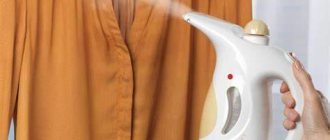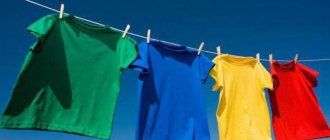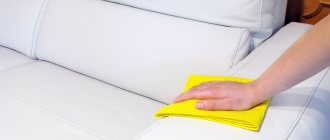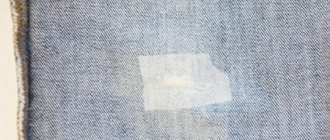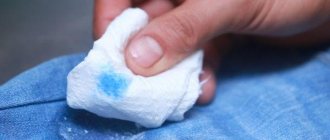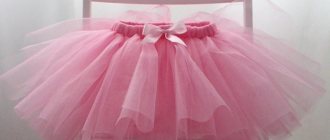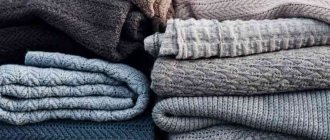What do the icons on the labels mean?
How to care for the item can be seen on the label. In addition to instructions regarding washing and drying, the labels contain ironing icons in the form of an iron in different designs:
| the icon indicates that the material can be processed with an iron, including using the machine ironing function; |
| the fabric is processed with an iron heated to 200 degrees, a similar designation is usually found on linen and cotton products; |
| The ironing temperature should not exceed 140 degrees; if there is no marking on the iron, then the slider is set to approximately the middle; |
| fabric can be ironed at 130 degrees, no higher, as a rule, these are items made of wool, viscose, polyester, polyester, silk; |
| the iron should be slightly heated, no more than 120 degrees - a mode used for working with delicate fabrics that require accuracy and caution; |
| The do not iron icon means that the item cannot not only be ironed, but also steamed; |
| If you see such a sign, you must turn off the steam function on the iron: the item cannot be steamed. |
The listed symbols for ironing clothes help set the temperature setting on the iron appropriate for a specific type of fabric.
It is important to know: it is better to start ironing with a low temperature, gradually bringing it to the maximum value.
Recently, many iron manufacturers have made it easier for housewives to choose the temperature setting. The instrument relays are marked not with a degree scale, but with letter designations: “wool”, “nylon”, “cotton” and so on. Before ironing the item, you should test the temperature on a piece of fabric (patch), which is usually located next to the label. If the fabric does not stick to the sole, then you can start ironing.
But it happens that the item is not equipped with a label with care instructions or the label was lost during wear. In this case, how can you determine at what temperature to iron the product? Let's try to figure it out.
Ironing complexly shaped clothes
Most of the methods described above are suitable for straightening simple items of clothing, such as a T-shirt. It is much harder to tidy up a shirt or pleated skirt.
The following ironing methods are most suitable for such products:
- Its complete absence. Things are completely wetted and carefully secured on hangers, tucks and other devices to avoid creases and bends. In this position, the shirt or blouse is left until completely dry.
- Ironing with a hot lamp. This method is suitable for extreme situations when it is urgent to get rid of wrinkles. Take a light bulb and carefully wipe it from dust and dirt, then screw it into the lamp. It is advisable to first remove the lampshade from it. Plug it in and wait for the light bulb to warm up well. Apply this “iron” over the surface of the product and remove all irregularities.
The use of the last available means is associated with some danger to humans. It is necessary to ensure that the lamp does not overheat too much, as bright scorch marks will appear on the product. Clothes must be completely dry and the lamp must be in good condition.
Is it possible to iron woolen items?
Not all wool products can be ironed. As a rule, after washing they are hung on a trempel and straightened well. To ensure that the clothing takes its original shape and does not become deformed, place a container of hot water under it. There are a few more important rules.
- It is not recommended to iron a coat, as the process may damage the material.
- After washing, the product is wrapped in a soft rag so that it absorbs all the moisture.
- The coat is then placed on a table or other horizontal surface. You cannot use another method - the coat may stretch and lose its original shape.
The label must be checked before each wash or ironing. Here you will find complete information about the washing temperature, as well as the possibility of ironing the product.
Temperature conditions for ironing main types of fabrics
Linen
Linen clothing has excellent breathable and thermal conductivity properties. With proper care, it retains its qualities for a long time. To ensure that linen items do not lose their original appearance, they require special care.
How to iron linen correctly:
- The iron temperature when ironing should be 180–200 °C (3 points).
- Turn inside out.
- Provide moisture to clothing. It is better to treat almost immediately after washing or use a spray bottle.
- Intense pressure on the iron.
- Allows you to turn on the steam function.
High-quality ironing of natural linen requires high temperature and humidity. We must not forget that this fabric wrinkles easily, so achieving an ideal result will be quite difficult.
If the material contains additions of other fibers, for example, cotton, then the temperature should not be set above 180 °C.
Particular attention should be paid to the presence of decorative elements. Embroideries and patterns are ironed exclusively from the inside and only through gauze
Direct contact with the base of the device is not allowed.
Very thick clothes are ironed on both sides, but using gauze. For starched items, the temperature should be reduced by about 10–20 °C from the maximum.
Cotton
Clothing made from this material is the most popular. Cotton is a fairly dense fabric that perfectly absorbs moisture and allows air to pass through well. It is used to make bed linen, dresses, shirts and many other things. To properly iron your products, you should follow these recommendations:
- Ironing temperature for cotton is 170–180°C.
- Do not dry completely. Treat wet or using a spray bottle.
- Press firmly on the iron.
- Using wet steam.
In its pure form, cotton is quite difficult to iron. The process requires high temperature and strong pressure. If the item contains the addition of polyester, the heating of the sole must be reduced to 110 °C.
Products without patterns or embroidery are processed from the outside; if there are decorative elements or paints, the clothes must be turned inside out. To obtain maximum effect, you must follow the recommendations indicated on the clothing label.
Silk
Silk is a delicate material that requires careful handling. It dries quickly and has a delicate texture. The fabric is very sensitive to external influences, so you need to know the main rules on how to iron silk.
Rules:
- Silk ironing temperature 60–80 °C (one dot or corresponding inscription on the device panel).
- The use of steam is prohibited. Difficult to remove stains may remain.
- Use a thin cloth, but not gauze. She also leaves streaks on the silk. In this case, a temperature increase of 10–20 is permissible.
- The direction of movement is vertical. Otherwise, the fabric may stretch.
How to iron a silk dress or shirt with a complex cut:
- Hang the product on hangers.
- Cover the top with a thin, slightly damp cloth.
- Heat the device to the temperature indicated on the label. If it is not possible to view the information, then set the mode to 1 point or 1 point on the iron.
- Slowly move the steam at a distance of 4–7 cm from the dress using vertical movements.
The same rules should be followed when working with chiffon and polyester.
Wool
Soft, natural material that is resistant to high temperatures. For safe ironing, you should adhere to the following rules:
- Temperature for ironing wool is 100–120 °C.
- Turn inside out.
- It is better to replace continuous moving of the iron by moving it from place to place. This method will avoid deformation of the fabric.
- Use additional moisture in the form of cotton fabric.
Woolen items are very finicky and do not always tolerate ironing. Read label recommendations carefully. It is better to give preference to vertical steaming for the ironing process.
Viscose
To avoid damage to clothes made from this material, use the following tips:
- Temperature maximum 120 °C.
- It is forbidden to get it wet, otherwise there will be streaks.
- Process only from the inside out.
- Use damp gauze or cotton cloth.
Chintz
Lightweight, thin, highly breathable material. For effective ironing you need:
- Do not increase the temperature above 170 °C.
- Iron from the front side of the product.
- Press firmly on the iron.
- Additional hydration.
Correctly selected ironing temperature is the key to obtaining excellent results.
How to iron properly without water?
First of all, you need to thoroughly drain the water from the tank. It is recommended to do this every time you put the iron away for storage. But before you start dry ironing, it doesn’t hurt to check again if there is any water in the steamer container. If the last few drops cannot be drained in any way, take an unnecessary piece of cloth and iron it in the steam mode until all the water has evaporated.
Before dry ironing, the steam supply is completely closed with the regulator. The item is ironed with quick movements. Usually you have to iron each item on both sides. The ironed item should be left to hang for 30–60 minutes.
We hope that our tips will help you learn how to iron without water correctly. And then your clothes will look perfect. It's worth the effort, isn't it?
Useful tips
Ironing may not be necessary if you dry things after straightening out all the creases:
- To keep mohair jackets and sweaters looking presentable, wrap them in a thick towel after washing, carefully twist them and lay them out horizontally to dry.
- Hang semi-dry clothes made from thin acrylic threads on hangers and smooth them out with your hands. To smooth out wrinkles, boil water, pour it into a bowl and hang the item over the steam.
- To remove creases from an openwork sweater, use a wooden rolling pin. First, wet two terry towels and wring them thoroughly. Place one on a horizontal surface, place clothes on top and cover with a second towel. Take a rolling pin and roll it over the terry material several times. The wrinkles in the clothing should be smoothed out. The same method is suitable for things with long pile, downy scarves.
- If you urgently need to get your hair in order, but you don’t have an iron at hand, a regular hair dryer will do. Cover the material with damp gauze, turn on the device and treat with hot air, holding it at a distance of 10 mm from the product.
- White wool threads are more afraid of high temperatures than others. This causes them to turn yellow and lose their attractive appearance, so steam and iron white clothes at low speed.
We recommend: An easy way to descale your iron: water and a little citric acid
Wool is a capricious material that can easily be damaged by a hot iron. To prevent this from happening, iron it as a last resort, do not exceed the permissible temperature and do not handle a wet item, otherwise it may stretch.
